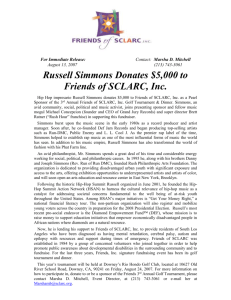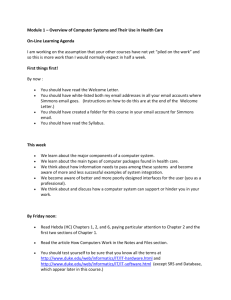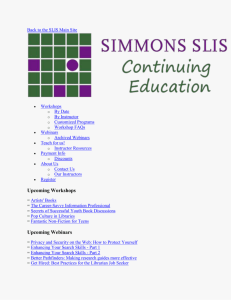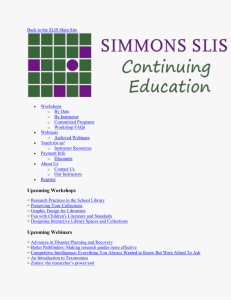Writing an Engaging Lead
advertisement
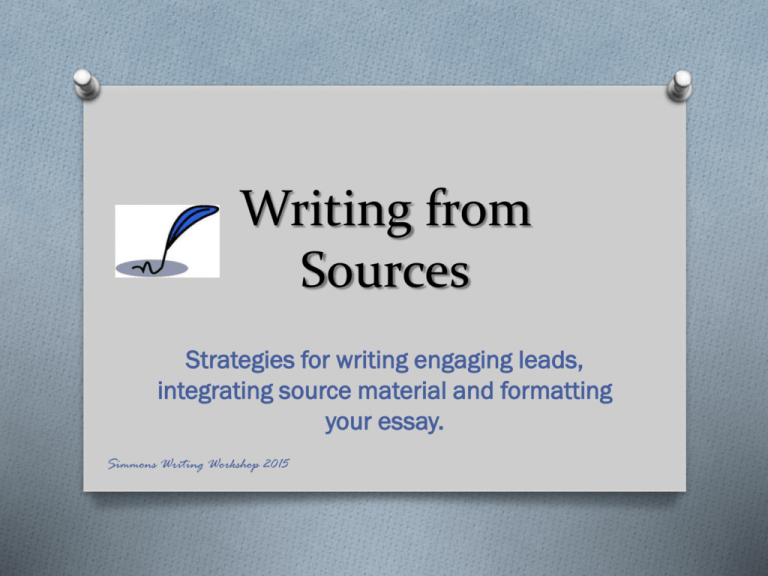
Writing from Sources Strategies for writing engaging leads, integrating source material and formatting your essay. Simmons Writing Workshop 2015 Components of an Introduction O Every introduction should contain the following: O An engaging lead or “hook” to draw the reader in O Background information about the topic/book/issue being discussed (2-3 sentences) O A thesis statement or a *position statement (*unique to argument writing) Simmons Writing Workshop 2015 Lead Strategies How to draw your readers in hook, line and sinker! Simmons Writing Workshop 2015 Tell a story O Use a an anecdote or hypothetical situation to engage your reader. O Ex: “Many years ago, I can recall trying out for the swim team with my best friend, Becca. Although we were best friends, I always felt that she was trying to outdo me when it came to swimming…” O Ex: “Imagine finding out that your best friend, who you share everything with, secretly hates you and is jealous of all your accomplishments…” Simmons Writing Workshop 2015 Use a Startling Statistic O Find a statistic or some type of data that your reader will find surprising, thus making them want to read more. O Ex: “In a recent survey of high school students, over 85% said they had lost a good friend due to what they consider to be “healthy competition…” Simmons Writing Workshop 2015 Use an Analogy O Compare something your audience knows and understands with something new and different. O Ex: “Competition among friends at an all-boys private school is as intense as a bunch of teenage girls trying to get first pick at a 50% off Forever 21 sale.” Simmons Writing Workshop 2015 Use a Quotation O Begin with a quote from a text or from a well- known figure that you can connect to a theme or an idea in your paper. O Ex: Jesse Owens once said, “Friendships born on the field of athletic strife are the real gold of competition. Awards become corroded, friends gather no dust.” Simmons Writing Workshop 2015 Ask a Question O You can lead in with either a question that you will immediately answer OR a rhetorical question. It MUST be thought-provoking and it MUST connect to the theme of your paper. O Ex: “Did you ever wonder how it must feel to have a best friend who is good at everything?” Simmons Writing Workshop 2015 What Comes Next? 1. Transition from your lead into some background information about your topic or about the text you are writing about. You must contextualize your topic so your reader has a frame of reference! 2. Be sure to include a TAG line (title, author, genre) 3. For a persuasive essay, the last part of your introduction should be your claim or position statement. 4. For other types of writing, your thesis goes after background info. Simmons Writing Workshop 2015 Body Paragraphs How to format and properly cite textual evidence Simmons Writing Workshop 2015 Components of a Body Paragraph O Each body paragraph should address one of the main points from your thesis or position statement. O Each body paragraph should have a topic sentence. O You must prove your ideas using textual evidence. O All evidence must be explained. Simmons Writing Workshop 2015 Introducing Text O To properly include textual evidence, follow the I.C.E. strategy I- Introduce quote or textual evidence In Chapter 2, Gene’s jealousy of Finny becomes apparent when he says, … Simmons Writing Workshop 2015 Introducing Text O To properly include textual evidence, follow the I.C.E. strategy c- cite the text …“I was beginning to see that Finny could get away with anything. I couldn’t help envying him a little.”(18) page # in parentheses Simmons Writing Workshop 2015 Introducing Text O To properly include textual evidence, follow the I.C.E. strategy E- explain and analyze the quote This shows us that, even though Gene outwardly goes along with everything Finny says and presents himself as his “best friend”, he still harbors some jealousy and animosity towards him.” Simmons Writing Workshop 2015 Wrapping Up Paragraph O Transition word or phrase + In conclusion As is evidenced in… In summary To conclude In closing Therefore As a result Thus, hence, so Finally Consequently O Restate the main point Simmons Writing Workshop 2015 Counterclaim (Argument Writing) O Also called the concession or counterargument O The other side of an argument O You must acknowledge counterargument or address different perspectives on the issue. O Introduce counterclaim with a transitional phrase that lets the reader know it’s an alternative viewpoint: Some say… Many believe… Simmons Writing Workshop 2015 Others may argue… Many people think… Refutation O Must come immediately after you’ve introduced the counterclaim O You must state in your paper why the counterclaim is invalid or less valid than your claim. O You must use evidence from the text to support your refutation. Simmons Writing Workshop 2015 Transitioning into Conclusion O Use some of these words to transition into a conclusion… In conclusion In summary In closing As a result Finally Simmons Writing Workshop 2015 As is evidenced in… To conclude Therefore Thus, hence, so Consequently Conclusion O Reassert your claim O Review the main points of your paper O Present final appeals/call to action O Do not include any new information O Come full circle O End with a clincher Simmons Writing Workshop 2015

